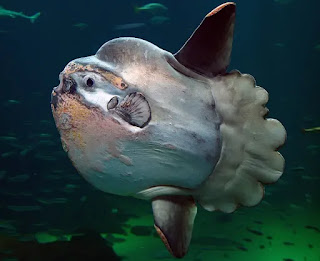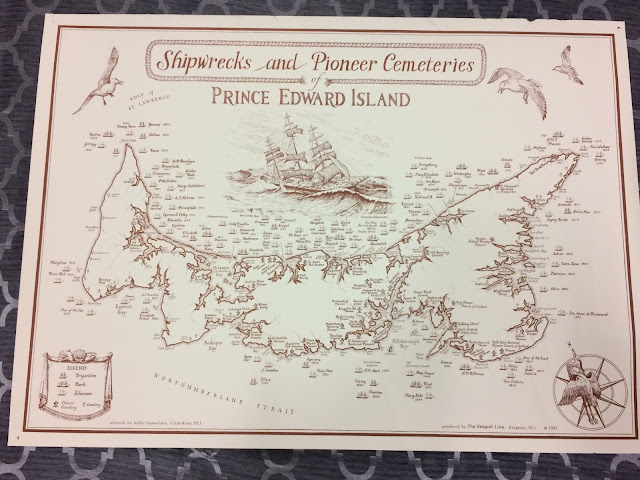Creatures of the Atlantic
Today we are looking at some of the creatures of the Atlantic (a much lighter topic than last time). As the Atlantic Ocean is so large, I'll be focusing on those found off the coasts of Atlantic Canada that we don't always think about. If you are a fisherman or a diver, you may have even seen some of these!
What is this Thing?
This giant fish is an ocean sunfish (mola mola). It can weigh up to 1,000 kilograms, or about 2,204 pounds, and can produce an exorbitant number of eggs (several hundred million at a time). While they are usually living about 200 metres underwater, they can be seen enjoying the sun closer to the surface. Sunfish prefer warmer waters so some theorize that they sunbath to get warm before diving to much deeper depths to hunt, mostly jellyfish and smaller fish.
Adults are preyed upon by killer whales, sharks, and sea lions. Younger sunfish can be prey to mahi-mahi and bluefin tuna.
Thankfully, despite its size, they are rarely aggressive towards humans and don't attack divers. However, they can be dangerous to the boats because of their size.
Their numbers are decreasing as more people start eating them and they can get caught in fishing gear.
Xenophyophores AKA Ocean Gardeners
Not much is known about them. They are so fragile that scientists can't move them and can cause damage if they try to take a small sample off one.
Adorable Teacup Octopus
This adorable octopus (bathypolypus arcticus) is the size of a teacup!
This octopus has one of the longest incubation periods. Once it lays its eggs, it will guard them until they hatch.
Adults found in the lower Bay of Fundy area were only about 45 grams or about 0.1 pounds!
This deep sea octopus also has a longer lifespan than those you find closer to shore. Shallow water octopuses tend to only live for about a year, but the bathypolypus arcticus can live for up to six years. For such a small creature, it can survive in a variety of environments. Although they usually live at depths between 200 to 600 metres, they have been seen in shallower waters and as deep as 1,500 metres.
But, I will admit, the main reason it is on this list is that it is adorable!
Giant Squids
Many of you have probably heard of giant squids in the Atlantic. In 1873, Newfoundland fisherman hauled up a 55-foot long squid. This discovery proved the existence of the giant squid to the international community.
Now if you are thinking those squids could do some damage...you would be right. Unlike their much smaller counterparts, giant squids can fight back. Sperm whales have been found with suction cup-shaped scars.
These squids usually stay in deeper waters but will sometimes be seen further inland.
In Newfoundland, there is a neat squid statue to pay homage to the 1873 giant squid, seen in the image below.
Over the last 200 years, there have been 60 recorded sightings of giant squids off the coast of Newfoundland. Must be a popular location.
Leatherback Sea Turtle
We don't see many turtles but they are here. You may remember one washed up on the Argyle Shore earlier this month. These turtles evolved around 100 million years ago so they co-existed with dinosaurs!
Adult leatherback turtles frequent waters close to the Atlantic provinces and on average their shells are 1.5 metres long and they weight about 400 kilograms or about 882 pounds.
And, perhaps the most surprising thing I learned is that their mouth, in the words of CBC's Cassie Williams, look like the Sarlacc in the Great Pit of Carkoon on Tatooine (Star Wars reference).
Their Sarlacc mouth makes it easier to eat jellyfish.
So there are five neat creatures living in the Atlantic you may not have known about. Know anymore?
If you like what I do here, please share this post, follow me on Facebook, and follow me on Twitter!
Sources:
CBC Digital Archives. "Sizable squid in Glovers Harbour, N.L." January 23, 2004. https://www.cbc.ca/archives/entry/sizable-squid-in-glovers-harbour-nfld
Day, Jim. "Large leatherback turtle washes up in Argyle Shore, P.E.I." The Guardian. https://www.theguardian.pe.ca/news/local/large-leatherback-sea-turtle-washes-up-in-argyle-shore-pei-266514/
Williams, Cassie. "Atlantic Canada is home to weird and wonderful creatures of the deep." CBC News. August 30, 2016. https://www.cbc.ca/news/canada/nova-scotia/atlantic-ocean-creatures-strange-interesting-1.3730711
What is this Thing?
 |
| The ocean sunfish is the heaviest known bony fish and is often mistaken for a shark (Image Credit: CBC) |
This giant fish is an ocean sunfish (mola mola). It can weigh up to 1,000 kilograms, or about 2,204 pounds, and can produce an exorbitant number of eggs (several hundred million at a time). While they are usually living about 200 metres underwater, they can be seen enjoying the sun closer to the surface. Sunfish prefer warmer waters so some theorize that they sunbath to get warm before diving to much deeper depths to hunt, mostly jellyfish and smaller fish.
Adults are preyed upon by killer whales, sharks, and sea lions. Younger sunfish can be prey to mahi-mahi and bluefin tuna.
Thankfully, despite its size, they are rarely aggressive towards humans and don't attack divers. However, they can be dangerous to the boats because of their size.
Their numbers are decreasing as more people start eating them and they can get caught in fishing gear.
Xenophyophores AKA Ocean Gardeners
"Where does a gardening, single-celled organism about the size of a grapefruit fit in the tree of life? That's a question scientists are struggling with."Sometimes I learn amazing things when I research these posts. Xenophyophores are the largest known single-cell organisms in the world. As they move they excrete slime on the ocean floor. They will then start moving in the other direction, moving over the slime, and eating the organic bits and materials that have begun to grow in/on the slime. But don't make the mistake of thinking they move quickly! They move painstakingly slow.
Not much is known about them. They are so fragile that scientists can't move them and can cause damage if they try to take a small sample off one.
Adorable Teacup Octopus
This adorable octopus (bathypolypus arcticus) is the size of a teacup!
 |
| Adorable teacup octopus (Image Credit: CBC) |
This octopus has one of the longest incubation periods. Once it lays its eggs, it will guard them until they hatch.
Adults found in the lower Bay of Fundy area were only about 45 grams or about 0.1 pounds!
This deep sea octopus also has a longer lifespan than those you find closer to shore. Shallow water octopuses tend to only live for about a year, but the bathypolypus arcticus can live for up to six years. For such a small creature, it can survive in a variety of environments. Although they usually live at depths between 200 to 600 metres, they have been seen in shallower waters and as deep as 1,500 metres.
But, I will admit, the main reason it is on this list is that it is adorable!
Giant Squids
Many of you have probably heard of giant squids in the Atlantic. In 1873, Newfoundland fisherman hauled up a 55-foot long squid. This discovery proved the existence of the giant squid to the international community.
Now if you are thinking those squids could do some damage...you would be right. Unlike their much smaller counterparts, giant squids can fight back. Sperm whales have been found with suction cup-shaped scars.
These squids usually stay in deeper waters but will sometimes be seen further inland.
In Newfoundland, there is a neat squid statue to pay homage to the 1873 giant squid, seen in the image below.
 |
| Image Credit: Readers Digest |
Over the last 200 years, there have been 60 recorded sightings of giant squids off the coast of Newfoundland. Must be a popular location.
Leatherback Sea Turtle
We don't see many turtles but they are here. You may remember one washed up on the Argyle Shore earlier this month. These turtles evolved around 100 million years ago so they co-existed with dinosaurs!
Adult leatherback turtles frequent waters close to the Atlantic provinces and on average their shells are 1.5 metres long and they weight about 400 kilograms or about 882 pounds.
And, perhaps the most surprising thing I learned is that their mouth, in the words of CBC's Cassie Williams, look like the Sarlacc in the Great Pit of Carkoon on Tatooine (Star Wars reference).
 |
| Leatherback turtle and Sarlacc (Image Credit: CBC News, originally Jon Augier/Museum Victoria & LucasFilm/Disney) |
Their Sarlacc mouth makes it easier to eat jellyfish.
So there are five neat creatures living in the Atlantic you may not have known about. Know anymore?
If you like what I do here, please share this post, follow me on Facebook, and follow me on Twitter!
Sources:
CBC Digital Archives. "Sizable squid in Glovers Harbour, N.L." January 23, 2004. https://www.cbc.ca/archives/entry/sizable-squid-in-glovers-harbour-nfld
Day, Jim. "Large leatherback turtle washes up in Argyle Shore, P.E.I." The Guardian. https://www.theguardian.pe.ca/news/local/large-leatherback-sea-turtle-washes-up-in-argyle-shore-pei-266514/
Williams, Cassie. "Atlantic Canada is home to weird and wonderful creatures of the deep." CBC News. August 30, 2016. https://www.cbc.ca/news/canada/nova-scotia/atlantic-ocean-creatures-strange-interesting-1.3730711



Comments
Post a Comment